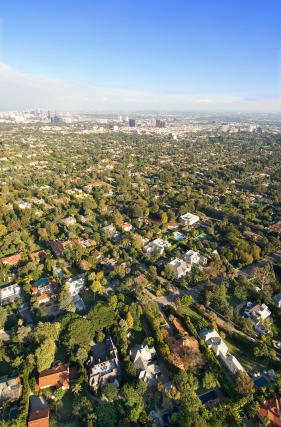
In the 1960s, California Gov. Edmund Gerald "Pat" Brown laid the foundation for building modern, suburban California with massive new highway projects and one of the most significant public water projects in history. The resulting infrastructure gave us broad, low-density developments with room for millions of Californians to have a home with a backyard and two cars in the driveway.
Those were the good old days. Today, Pat Brown's son Jerry is waging war on the very communities his father helped make possible. Why? Global warming.
Jerry Brown has been a fixture of the state's politics for more than three decades. He was elected governor in 1974 and four years later earned the moniker "Governor Moonbeam" for his interest in creating a space program in California. In 1998, he was elected mayor of Oakland, a working-class city across the bay from San Francisco. And in 2006, he was elected attorney general. Today he is mulling a run for governor in 2010, when he will be 72.
In the meantime, Mr. Brown is taking aim at the suburbs, concerned about the alleged environmental damage they cause. He sees suburban houses as inefficient users of energy. He sees suburban commuters clogging the roads as wasting precious fossil fuel. And, mostly, he sees wisdom in an intricately thought-out plan to compel residents to move to city centers or, at least, to high-density developments clustered near mass transit lines.
Mr. Brown is not above using coercion to create the demographic patterns he wants. In recent months, he has threatened to file suit against municipalities that shun high-density housing in favor of building new suburban singe-family homes, on the grounds that they will pollute the environment. He is also backing controversial legislation -- Senate bill 375 -- moving through the state legislature that would restrict state highway funds to communities that refuse to adopt "smart growth" development plans. "We have to get the people from the suburbs to start coming back" to the cities, Mr. Brown told planning experts in March.
The problem is, that's not what Californians want. For two generations, residents have been moving to the suburbs. They are attracted to the prospect, although not always the reality, of good schools, low crime rates and the chance to buy a home. A 2002 Public Policy Institute of California poll found that 80% of Californians prefer single-family homes over apartment living. And, even as the state's traffic jams are legendary, it is not always true that residents clog roads to commute to jobs in downtown Los Angeles or other cities.
Ali Modarres, associate director of the Edmund G. "Pat" Brown Institute of Public Affairs at California State University Los Angeles, believes the density-first approach is ill-suited for areas like L.A. County, where most residents and jobs are dispersed among subregional "nodes." Research by Mr. Modarres, co-author of the powerful book "City and Environment," demonstrates that people living in nodes -- Pasadena, Torrance, Burbank and Irvine -- often enjoy considerably shorter average commutes than do a lot of inner-city residents. Many of these people commute through tangled traffic to get to jobs on the periphery.
"I have no problem trying to find solutions on global warming," Mr. Modarres told me, "but I doubt these kinds of solutions are going to do anything. The whole notion that through physical planning you can get a lot of people to abandon their cars is pretty iffy."
Mr. Modarres also points out that forcing developers to build near transit lines, a strategy favored by "smart-growth advocates," does not mean residents will actually take the train or bus. A survey conducted last year by the Los Angeles Times of "transit oriented development" found that "only a small fraction of residents shunned their cars during rush hour."
There is also little punch behind the science used to justify the drive to resettling the cities -- and plenty of power behind the argument that suburbs are better for Mother Earth. Several prominent scholars -- including University of Maryland atmospheric scientist Konstanin Vinnikov, University of Georgia meterologist J. Marshall Shepard and Brookings Institution research analyst Andrea Sarzynski -- have found there is little evidence linking suburbanization to global warming, pointing out that density itself can produce increased auto congestion and pollution.
The antisuburbanites also ignore evidence that packing people together in cities produces "heat islands." Temperatures in downtown Los Angeles sometimes reach as much as three degrees centigrade higher than outlying areas. Recent studies in Australia have shown that multistoried housing generates higher carbon emissions than either townhomes or single-family residences because of the energy consumed by common areas, elevators and parking structures, as well as the lack of tree cover.
In the short run, while being "tough" on climate change appears popular, an assault on the preferred lifestyle of suburban voters may not. These voters aren't likely to appreciate being castigated as ecological evildoers, especially by people who generally house themselves in spacious splendor.
A report by the Los Angeles Weekly's Dave Zahniser -- entitled "Do as We Say, Not as We Do" -- found that a lot of prominent "smart growth" advocates in Los Angeles live in large single-family homes, some of them long hikes from mass transit. Mr. Brown himself, not long ago, moved from a loft in crime-ridden downtown Oakland to a bucolic setting in the Oakland Hills.
At a time when political trends favor Democrats, a hypocritical jihad against basic middle-class aspirations may not be the best strategy. Mr. Brown would be better off embracing telecommuting and other ideas to cut suburban commutes that accommodate the majority's dreams and preferences. He might have learned that from his father. Instead he's gone from wanting to launch people into space to opposing people who move to the suburbs.
This article first appeared in the Wall Street Journal.












